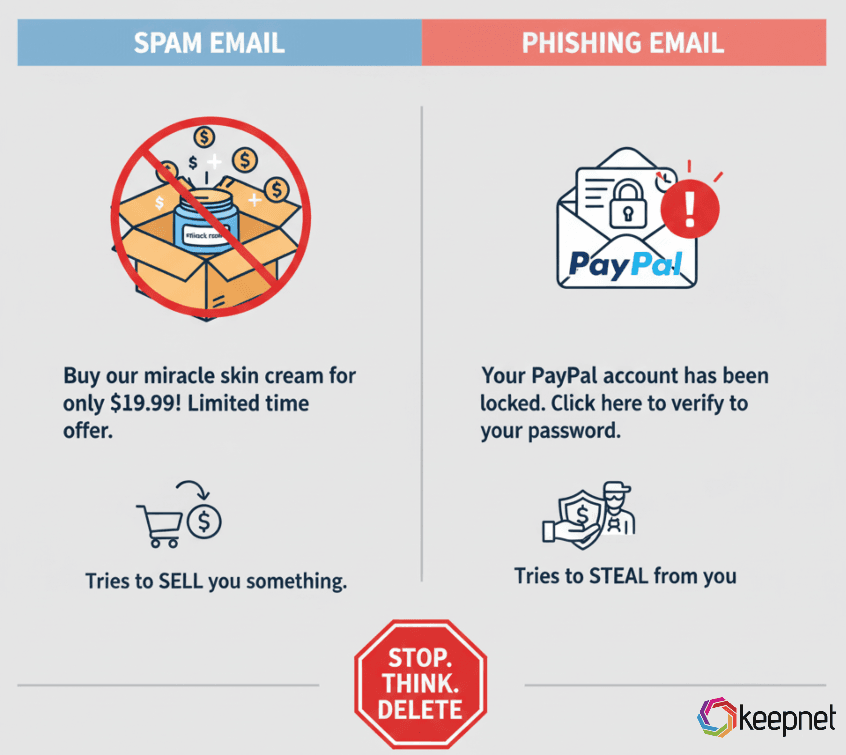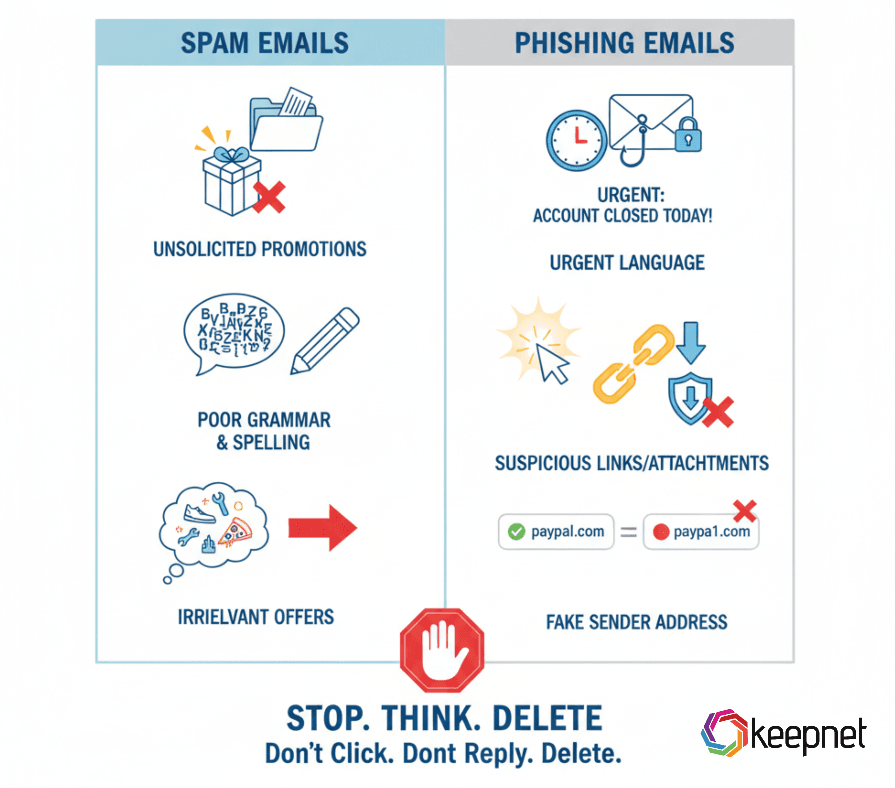Spam vs Phishing: What’s the Difference and Why It Matters
Confused about spam vs phishing? Spam is unwanted junk, while phishing is a cyberattack designed to steal your data. This guide explains the difference between spam and phishing emails, shows real-world examples, and shares proven strategies to protect yourself.
Many people still ask the same question: “What is the difference between spam and phishing?” At first glance, they may look the same, unwanted emails landing in your inbox. But the truth is, spam and phishing are not the same thing. Understanding the difference between spam and phishing emails can protect you from falling victim to cyberattacks that cost businesses millions every year.
In this guide, we’ll break down spam vs phishing, provide real examples, and explain how to defend against both in 2025.
What Is Spam?
Spam refers to unsolicited, bulk messages sent to a large number of recipients. Think of it as digital junk mail. Most spam emails are used for advertising products, shady services, or scams that are not personalized to you.
Goal of spam:
Promotion, advertising, or mass distribution.
Examples of spam emails:
- Fake weight loss products.
- “Get rich quick” investment schemes.
- Irrelevant offers from unknown companies.
While spam is annoying, it’s usually less dangerous than phishing. However, spam can still expose users to malware if they click unsafe links.
What Is Phishing?
Phishing is far more dangerous. It is a targeted cyberattack designed to trick you into sharing sensitive data such as passwords, credit card numbers, or personal information. Check our guide to learn what is phishing and how it works.
Goal of phishing:
Steal information or gain access to systems.
Examples of phishing emails:
- Fake bank login requests.
- “Your account has been suspended” notices.
- Emails pretending to be from Microsoft, Google, or your company’s IT team.
Check this article to get more details on common phishing examples.
Unlike spam, phishing attacks often look legitimate and exploit trust to make victims click.
Spam vs Phishing: The Key Differences
Here’s the difference between spam and phishing emails in simple terms:
- Spam = mass, unwanted, irrelevant messages (annoying but often harmless).
- Phishing = targeted, malicious attempts to steal information (very dangerous).
Think of spam as noise in your inbox, while phishing is a trap.
Why People Confuse Spam and Phishing
It’s common for people to say things like, “Spam and phishing emails are the same thing.” But that’s not accurate. Both end up in your inbox, but the intention behind them is completely different.
- Spam = commercial nuisance.
- Phishing = cybercrime.
This confusion is why search terms like “spam vs phishing”, “phishing vs junk”, and “what’s the difference between spam and phishing emails” are popular on Google.
Examples: Spam vs Phishing in Action
Let’s make it practical.
- Spam email example: “Buy our miracle skin cream for only $19.99! Limited time offer.”
- Phishing email example: “Your PayPal account has been locked. Click here to verify your password.”

The first is trying to sell you something. The second is trying to steal from you.
How to Recognize Spam and Phishing Emails
To protect yourself, look out for these signs:
Signs of Spam
Unsolicited promotions.
- Poor grammar and spelling.
- Irrelevant offers.
Signs of Phishing
Urgent language (“Your account will be closed today”).
Suspicious links or attachments.
Sender address doesn’t match the real company.

Business Risk: Why Spam and Phishing Matter in 2025
For individuals, spam is an inconvenience. For businesses, phishing is a top security threat. According to cybersecurity reports, over 90% of successful cyberattacks start with a phishing email.
Attackers are also evolving. Today, phishing comes not just by email but also via SMS (smishing), voice calls (vishing), QR codes (quishing), and even deepfake phishing.
How to Protect Yourself from Spam and Phishing
- Use spam filters: Most email providers can block bulk junk mail.
- Train employees: Security awareness training reduces phishing risks.
- Verify before clicking: Hover over links and check senders.
- Report suspicious emails: Don’t just delete; help your organization track threats.
- Use phishing simulators: Companies can test employee resilience safely.
Protecting Against Spam and Phishing with Human Risk Management
Understanding spam vs phishing is more than a vocabulary exercise—it’s a matter of protecting your personal data and your business.
Spam is junk; phishing is a weapon. Knowing the difference helps you respond correctly.
At Keepnet, we help organizations reduce human risk by providing:
- Security Awareness Training
- Phishing Simulations (including voice, SMS, QR, and MFA-fatigue phishing).